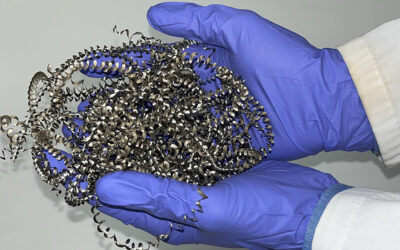A colorimetric assay system based on urine and plasmonic nanoparticles for mercury ion detection has been developed by researchers from Nanyang Technological University.
Writing in Small, the researchers report the use of urine, an environmentally friendly product, as an active component to produce a simple, inexpensive, and portable colorimetric Hg2+ sensing assay for the first time. This colorimetric “readout” circumvents the relative complexity inherent in conventional optical imaging/detection methodologies and thus may prove to be suitable for low-cost point-of-care diagnostics. The assay shows high selectivity and sensitivity by simply mixing gold nanoparticles and urine. The synergetic effect of uric acid and creatinine decorated on AuNPs is the reason for selectively binding Hg2+, leading to the aggregation of gold nanoparticles and thereby causing a visual color change.
Plasmonic NP-based colorimetric detection, especially AuNPs, has drawn increasing attention in last two decades due to their unique optical properties of surface plasmon resonance (SPR). Specifically, due to the sensitive and obvious red-to-blue color change, AuNPs prove to be an important colorimetric platform and AuNPs-based colorimetric assays have been successfully designed and widely applied for detecting DNA, enzyme activity, protein, small molecule, and metal ion/anion depending on their superior properties, such as the high dispersity in aqueous media, greater absorption extinction coefficient, good stability and low toxicity, ease of physical and chemical functionalization with large surface-to-volume ratio, and alterable optical properties (e.g. SPR).
In order to develop an environmentally friendly and sustainable method rather than the complicated chemical synthesis in AuNPs system, utilizing natural products with efficient functional groups is one of the most simple and efficient strategies, consistent with the ideas of green chemistry and low costs. Since the uric acid and creatinine in the urine possess as similar functional sites as thymine that is used as Hg2+ recognition ligand, it is interesting to find that the normal urine obtained from healthy people could act as recognizing ligands for sensing the heavy metal ion, Hg2+, on the basis of synergetic coordination chemistry between uric acid/creatinine and Hg2+ on the surface of AuNPs. The unique of such assay lies in its simplicity, inexpensiveness, and portability, which is very useful in remote and less industrialized areas.
The first author of the paper, Dr. Jianjun Du, looks ahead: “It is exciting to imagine the frontiers of such paradigm-shifting applications and we believe that plasmonic nanoparticle based field assays and diagnoses could bring us a much more ‘colorful’ and bright future.”
“It is worthy to note that the progress in this emerging field is impossible without the cross-fertilization between the chemistry, physics, biology, materials science, and engineering communities”, adds Prof. Xiaodong Chen, Nanyang Technological University, the corresponding author of the paper, “this assay development shows as a good example to exploit natural products, like urine in our work, in exploring nanotechnology”.
















